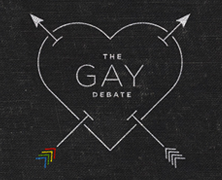The position of social conservatives regarding homosexuality is based on the conviction that homosexual conduct is objectively harmful. The most obvious evidence of this is the negative physical health consequences which can result directly from homosexual acts, and the most dramatic of those negative consequences is the highly elevated risk of HIV infection and AIDS among men who have sex with men (MSM). Of all the Americans who have died of AIDS since the epidemic began nearly three decades ago, more than a quarter million of them have been men whose only known risk factor was that they had sex with other men.[i] Researchers recently calculated that homosexual men are approximately fifty times more likely to be HIV-positive than heterosexual men.[ii] And the reason is no mystery – the practice of anal intercourse is more likely to transmit the virus,[iii] and the tendency of homosexual men to have multiple sex partners[iv] is more effective at spreading it.
However, HIV/AIDS is not the only sexually transmitted disease for which homosexual men are at risk. The CDC warns, “Men who have sex with men (MSM) are at elevated risk for certain sexually transmitted diseases (STDs), including Hepatitis A, Hepatitis B, HIV/AIDS, syphilis, gonorrhea, and chlamydia.”[v]
Although not as dramatic, problems with sexually transmitted disease are also found among lesbians. In 2007, a medical journal reported, “Women who identified as lesbians have a 2.5-fold increased likelihood of BV [bacterial vaginosis] compared with heterosexual women.”[vi] The Gay and Lesbian Medical Association also reports, “Lesbians have higher risks for many of the gynecologic cancers.”[vii]
While those who suffer these illnesses are obviously the primary victims, such health problems impose a cost upon society as well. Billions of dollars have been spent treating such illnesses, as well as in searching for cures and operating prevention programs, and in many cases the money must come from taxpayers and all who pay insurance premiums. Such expenditures are necessary to meet the immediate need – but they could also have been avoided had people abstained from the behavior which leads to such illnesses. This is a large part of what social conservatives mean when they argue that “homosexual behavior is harmful to society.”
Mental Health Problems Associated with Same-Sex Attractions and Homosexual Conduct
In addition to suffering higher rates of physical illness, evidence shows that homosexuals experience higher levels of mental illness as well. This fact is also not in dispute. For example, the Southern Poverty Law Center, in its article “10 Anti-Gay Myths Debunked,” says one such “myth” is, “Homosexuals are more prone to be mentally ill and to abuse drugs and alcohol.” Yet in their own explanation of “the facts,” they declare, “It is true that LGBT people suffer higher rates of anxiety, depression, and depression-related illnesses and behaviors like alcohol and drug abuse than the general population.”[viii]
The real debate is not over whether these problems exist, but over their cause. Whereas many of the physical health problems experienced by homosexuals are a direct result of their sexual conduct, it is much more difficult to identify direct causation in the case of mental illnesses. Social conservatives understand that correlation is not causation, and it is not clear whether homosexual conduct might lead to mental illness, mental illness might lead to same-sex attraction and/or homosexual conduct, or whether some independent factor or factors are also at work. Even if one accepts the declaration by the American Psychiatric Association in 1973 that homosexuality is not in itself a mental illness, there is no question that there is a correlation between homosexuality and higher rates of mental illness. The nature of and reasons for that correlation are likely highly complex, and are in any case legitimate subjects for research and debate.
Those who believe in the “gay identity” paradigm, however, offer a single, simplistic answer for the higher rates of mental illness among homosexuals – they claim that societal discrimination is the cause. While this claim has theoretical appeal, it cannot merely be accepted as an article of faith – it must be empirically verified. For example, if mental health problems among homosexuals were caused by discrimination, one would expect that they would much more severe in places with higher levels of “discrimination,” and much less severe in places where homosexuals are widely accepted. Yet this is not what the research shows. For example, even in the Netherlands – perhaps the most “gay-friendly” country in the world – a study showed “a higher prevalence of substance use disorders in homosexual women and a higher prevalence of mood and anxiety disorders in homosexual men.”[ix] Another recent study found that even in areas with a more “supportive social environment,” teenagers who self-identified as “gay” were five times more likely to attempt suicide than heterosexual teens.[x]
[i] Centers for Disease Control and Prevention, HIV Surveillance Report, 2009; vol. 21 (February 2011), Table 12a, p. 42; online at: http://www.cdc.gov/hiv/surveillance/resources/reports/2009report/pdf/2009SurveillanceReport.pdf. The actual number (through 2008) was 263,652.
[ii] Dyana Bagby, “Gay, bi men 50 times more likely to have HIV: CDC reports hard data at National HIV Prevention Conference,” Washington Blade, August 28, 2009.
[iii] A federal report says, “HIV/AIDS can be sexually transmitted by anal, penile-vaginal, and oral intercourse. The highest rate of transmission is through anal exposure.” National Institute of Allergy and Infectious Diseases, Workshop Summary: Scientific Evidence on Condom Effectiveness for Sexually Transmitted Disease (STD) Prevention (National Institutes of Health, Department of Health and Human Services, July 20, 2001), p. 13. Online at: http://www.niaid.nih.gov/about/organization/dmid/documents/condomreport.pdf.
[iv] For example, the 1994 National Health and Social Life Survey found that when men who have had any homosexual activity in the past year are compared with men who have had only heterosexual activity in the past year, the men who had sex with men reported five times as many sexual partners over the past five years (an average of 20.7 vs. 4.9). Edward O. Laumann, John H. Gagnon, Robert T. Michael, and Stuart Michaels, The Social Organization of Sexuality: Sexual Practices in the United States (Chicago: University of Chicago Press, 1994), p. 315, Table 8.4.
A survey of 2,583 “homosexually active men” in Australia found that among those age 50 or older, “the modal range for number of male sexual partners ever was 101-500 (21.6%),” and over 10% reported having had more than a thousand homosexual partners. Over 70% of respondents aged 25 and older were not monogamous or celibate at the time of the survey, and “almost half (48.9%) of the older men had sex with a casual partner one to five times per month.” Paul Van de Ven, Pamela Rodden, June Crawford, Susan Kppax, “A Comparative Demographic and Sexual Profile of Older Homosexually Active Men,” Journal of Sex Research Vol. 34, No. 4 (1997): 354.
The United Kingdom’s National Surveys of Sexual Attitudes and Lifestyles in 2000 found, “46% of MSM [men who have sex with men] reported five or more partners in the past 5 years, and 59.8% reported unprotected anal intercourse in the past year.” The average number of male sexual partners for MSM in the previous five years was 24.1, and “nearly one in ten reported at least 50 males partners in this time.” Catherine H. Mercer, Kevin A. Fenton, Andrew J. Copas, Kaye Wellings, Bob Erens, Sally McManus, Kiran Nanchahal, Wendy Macdowall and Anne M. Johnson, “Increasing prevalence of male homosexual partnerships and practices in Britain 1990-2000: evidence from national probability surveys,” AIDS Vol. 18, No. 10 (2004), pp. 1453, 1455.
[v] Centers for Disease Control and Prevention, “Viral Hepatitis And Men Who Have Sex With Men,” online at: http://www.cdc.gov/hepatitis/Populations/msm.htm.
[vi] Amy L. Evans, Andrew J. Scally, Sarah J. Wellard, Janet D. Wilson, “Prevalence of bacterial vaginosis in lesbians and heterosexual women in a community setting,” Sexually Transmitted Infections 2007; 83:470-475; abstract online at: http://sti.bmj.com/content/83/6/470.abstract.
[vii] Katherine A. O’Hanlan, “Top 10 Things Lesbians Should Discuss with their Healthcare Provider” (San Francisco: Gay & Lesbian Medical Association); online at: http://www.glma.org/_data/n_0001/resources/live/Top%20Ten%20Lesbians.pdf.
[viii] Evelyn Schlatter and Robert Steinback, “10 Anti-Gay Myths Debunked,” Intelligence Report No. 140 (Southern Poverty Law Center, Winter 2010); online at: http://www.splcenter.org/get-informed/intelligence-report/browse-all-issues/2010/winter/10-myths.
[ix] Theo G. M. Sandfort, Ron de Graaf, Rob V. Bijl, Paul Schnabel, “Same-Sex Sexual Behavior and Psychiatric Disorders: Findings From the Netherlands Mental Health Survey and Incidence Study (NEMESIS),” Archives of General Psychiatry 58 (January 2001), pp. 88-89.
[x] Mark L. Hatzenbuehler, “The Social Environment and Suicide Attempts in Lesbian, Gay, and Bisexual Youth,” Pediatrics Vol. 127, No. 5 (May 2011), pp. 896-903.










